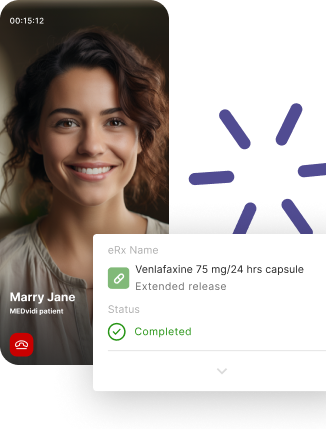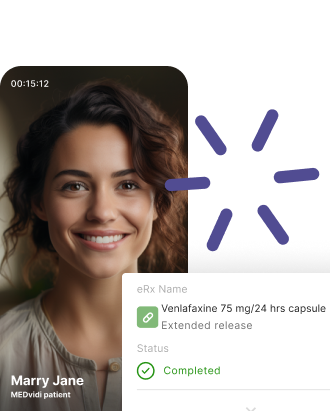Xanax has a boxed warning, the most serious type of warning from the Food and Drug Administration (FDA). Xanax’s active ingredient alprazolam has an increased risk of abuse, misuse, addiction, dependence, withdrawal reactions, and even death. Concomitant use of Xanax and opioids poses danger. Xanax is also a controlled substance, indicating its high potential for misuse or dependence. Specific federal and state laws limit the amount of this medication that can be prescribed or dispensed within a certain period of time.
Highlights
- Xanax (alprazolam) is a benzodiazepine medication prescribed for short-term anxiety treatment.
- Getting prescribed Xanax online is only possible after a consultation with a healthcare provider and if deemed appropriate.
- Xanax can cause side effects and has several contraindications. Remember to discuss these with your healthcare provider.
Brand name: Xanax, Xanax XR
Generic name: Alprazolam
Drug class: Benzodiazepines
Dosage forms: oral tablet
FDA-approved uses: Generalized anxiety disorder; panic disorder, with or without agoraphobia
Everyone may feel unpleasant inner turmoil, dread an anticipated event, experience uneasiness or increased irritability from time to time. However, when restlessness and worrying become constant and affect daily life, it can indicate an anxiety disorder.
Anxiety disorders are some of
Note that booking an appointment doesn’t guarantee obtaining a prescription. The decision is at the discretion of your healthcare provider.
What Is Xanax?
Xanax belongs to the class of medications called benzodiazepines and falls under the category of controlled substances. The medication is also sold under the generic name alprazolam. The FDA approved Xanax for the short-term treatment of anxiety disorders. It is also sometimes used off-label for conditions like insomnia, depression, and premenstrual syndrome.
How Does Xanax Work?
Xanax is a short-acting central nervous system depressant. It enhances the activity of an inhibitory neurotransmitter called gamma-aminobutyric acid (GABA). GABA is responsible for reducing the activity of certain neurons: it inhibits nerve transmission in the brain, which leads to calming and anxiolytic effects and relaxes the body while reducing anxiety symptoms.
What Conditions Qualify for Xanax?
Xanax is often prescribed for short-term treatment of generalized anxiety disorder and panic disorder with or without agoraphobia. Generalized anxiety disorder is associated with marked worry and anxiousness for prolonged periods. Panic disorder is characterized by panic attacks that cause intense feelings of terror or fear.
The use of Xanax for depression is highly controversial because it has a high potential for abuse and
Xanax may also be prescribed off-label to some

The medical need for a Xanax prescription can only be determined by licensed healthcare professionals.
How to Get Xanax Prescribed Online
At MEDvidi, an online prescription for Xanax can be obtained after a detailed assessment. Our medical providers are authorized to prescribe anxiety medication online if the patient’s condition requires such treatment. Here is what’s involved in this process:
- Step 1. Create an account on MEDvidi and fill in your intake form and other documentation to join the platform.
- Step 2. Book an appointment with a qualified healthcare professional by choosing the most convenient date and time.
- Step 3. Connect with a provider through a video call. They will analyze your symptoms, make a diagnosis based on your evaluation, and provide you with an online prescription if deemed medically appropriate.
- Step 4. Attend follow-up appointments to monitor your response to treatment and renew your prescription if required.
It’s important to rely on the doctor’s choice of the most suitable medication for you, which may or may not be Xanax. The choice depends on many factors, including your symptoms, diagnosis, and health history.
Professional help for anxiety


Xanax Cost
Different factors can affect the cost of Xanax tablets, from the prescribed dosage to your location to insurance coverage (including varied policies and requirements of different insurance providers). For example, the cost of 30 Xanax tablets of 0.25 mg ranges from $184 to $208, while the same supply of 0.5 mg tablets will cost from $237 to $260, depending on the pharmacy. Generic Xanax (alprazolam) costs from $14 to $28 for 30 tablets of 0.5 mg. You can decrease the cost of brand and generic Xanax by using coupons.
Note that these are not exact prices, and it’s recommended to contact your pharmacy to get the most up-to-date information.
Xanax is a controlled substance. Because of this, you may be limited to the amount of Xanax you can get from a pharmacy at one time, according to your prescription.
Xanax Dosage
According to the label, Xanax dosage can differ depending on the condition, medication form (immediate-release or extended-release), sensitivity to the effects of alprazolam, and the need for early discontinuation. Your healthcare provider will choose an appropriate dosage based on the assessment of your general health and mental health. They will also instruct you on dealing with missed doses and provide other necessary instructions.
Please contact your healthcare provider if you notice the symptoms of dependence and misuse:
- preoccupation with the medication,
- severe withdrawal symptoms when stopping the treatment,
- the desire to take higher doses, and other disturbing behaviors.
Follow your healthcare providers instructions on how to take Xanax. It is important that you do not take Xanax more often or take a higher dosage than they instruct you to do, so that they can be sure that Xanax is safe for you.
Xanax Side Effects
The most common side effects of Xanax are the following:
- Nervousness
- Drowsiness
- Lightheadedness
- Low blood pressure
- Confusion
- Headache
- Dry mouth
- Palpitation
- Lethargy
- Lack of coordination
- Forgetfulness
- Slurred speech
- Decreased libido
Another strongly associated adverse effect to consider is
Note that this may not be a comprehensive list of Xanax side effects. Remember to discuss possible adverse reactions and warning signs with your healthcare provider.
If you’re experiencing suicidal or self-harming thoughts and require immediate assistance, contact a crisis hotline, such as 911, 988 suicide & crisis lifeline (toll-free), or Samaritans (116-123 or via chat).
Do You Need a Prescription for Xanax (Alprazolam)?
Yes, Xanax is a prescription medication. This implies that in order to lawfully obtain it from a pharmacy, you would need a valid prescription from a qualified healthcare provider.
Because Xanax is a benzodiazepine, it has an extremely high potential for abuse and dependence. Because of its sedative effects and the high risk of misuse and abuse, it is prescribed cautiously and for intermittent and short-term use, often not exceeding two weeks in duration. Obtaining Xanax without a prescription is illegal.
Who Can Prescribe Xanax?
Since Xanax is a controlled substance, only licensed medical professionals can prescribe it. In the United States, psychiatrists, medical doctors, and advanced practice medical professionals, such as nurse practitioners and physician assistants, can prescribe it. The list of authorized professionals may vary depending on state laws.
Medical providers at MEDvidi are authorized to prescribe Xanax after an online consultation for anxiety in Arizona (AZ), California (CA), Colorado (CO), Florida (FL), Georgia (GA), Illinois (IL), Indiana (IN), Kentucky (KY), Maine (ME), Michigan (MI), Minnesota (MN), New Mexico (NM), New York (NY), North Carolina (NC), Ohio (OH), Oregon (OR), Pennsylvania (PA), Tennessee (TN), Texas (TX), Virginia (VA), Vermont (VT), Washington (WA), Wisconsin (WI).
Who Shouldn’t Be Prescribed Xanax?
While Xanax can effectively manage some mental health conditions, certain individuals should not use it. Others may require careful consideration and monitoring when taking it. Examples include the following:
- Allergies or sensitivities. People who have previously had hypersensitivity or an allergic reaction to Xanax, the active ingredient alprazolam, or other benzodiazepines shouldn’t take Xanax.
- Respiratory issues. Xanax can adversely affect breathing, so anyone with respiratory problems such as chronic obstructive pulmonary disease (COPD), asthma, or sleep apnea requires careful monitoring when using this medication.
- Liver or kidney problems. Since the liver is primarily responsible for metabolizing (breaking down) Xanax, people with severe liver disease should use this medication cautiously or not at all. Similarly to this, dosage modifications may be necessary for people with severe kidney dysfunction.
- Substance use disorders. Particularly in people with a history of drug use disorders or addiction, Xanax has the potential to be abused and become
addictive[6] . In these circumstances, it should be used sparingly or avoided completely. - Age. The sedative effects of Xanax are typically more potent in older persons, which might raise the risk of falls, disorientation, and other side effects. For this population, lower doses are necessary and for these reasons, it is rarely deemed safe to prescribe Xanax in this population.
In addition, taking Xanax during pregnancy is generally not advised due to potential hazards to the growing fetus. The medication might also enter the breast milk and impact the nursing child. Consult your doctor to know what medication is suitable in this case.
Remember to discuss your medical history with your healthcare provider, including any health conditions and medications you are taking, to avoid interactions and learn more about contraindications and risks.

Interactions With Other Medications
Other sedatives, anticonvulsants, certain antibiotics, antifungal medicines, and some antidepressants can all interact with alprazolam. These combinations may intensify negative effects or alter the metabolism of Xanax or co-administered medications. Using benzodiazepines like Xanax together with opioids is dangerous: it can lead to stronger sedation, respiratory depression, coma, and even death. Make sure to tell your healthcare provider about any prescription or over-the-counter medications, herbs, or supplements that you take so they can make sure Xanax is safe for you.
Alternative Treatments for Anxiety
Depending on the diagnosis and individual health history, a medical professional may prescribe other benzodiazepines, such as Valium (diazepam) or Ativan (lorazepam), or non-benzodiazepine alternatives for anxiety management. However, benzodiazepines are usually prescribed for short-term treatment of anxiety because they carry risks of tolerance and dependency. They may not be suitable for individuals with a history of substance abuse or certain health conditions, such as respiratory issues, sleep apnea, and liver disease.
For long-term anxiety management, it’s more common to consider the following options:
- Selective serotonin reuptake inhibitors (SSRIs): sertraline (Zoloft), fluoxetine (Prozac), escitalopram (Lexapro). They are not habit-forming and can be used over a longer period compared to benzodiazepines.
- Serotonin-norepinephrine reuptake inhibitors (SNRIs): such as venlafaxine (Effexor) or duloxetine (Cymbalta).
- Buspirone: has lower risks of dependency and sedation compared to benzodiazepines.
Pharmacological treatment combined with psychotherapy can lead to better results. Talk therapy itself, such as dialectical behavior therapy (
In addition, your healthcare provider may recommend lifestyle changes. For example,
The Bottom Line
Today, it’s possible to consult with a licensed healthcare professional online, who may prescribe medications like Xanax if deemed medically appropriate. A doctor will evaluate your symptoms, make a diagnosis, and offer a course of treatment. Contact us to consult with qualified medical experts.
FAQ
Why won't doctors prescribe Xanax?
Given the potential for dependence and abuse, doctors may exercise extra caution when recommending benzodiazepines like Xanax (alprazolam). Benzodiazepines carry a high risk of addiction and can result in cognitive impairment, sedation, and sleepiness. They are often administered for brief periods of time and for specific ailments, including panic attacks and anxiety disorders.
Is Xanax used long-term?
No, Xanax is not usually used as a long-term treatment because of the increased risk of severe side effects. Also, when stopping Xanax, you’ll likely do it slowly using a taper schedule. This will help decrease the risk of withdrawal symptoms (these are side effects that can happen when you stop taking a medication your body has become used to). Talk with your doctor about your possible duration of treatment and dosage taper schedule.
How can I legally get Xanax?
You require a legitimate prescription from a licensed healthcare provider in order to purchase Xanax legally. It is advised that you speak with a healthcare provider if you are exhibiting signs of anxiety or other mental health problems.
Can I buy Xanax online?
You can only purchase Xanax online from a legitimate pharmacy if you have a prescription provided by a licensed medical professional. Online pharmacies that sell prescription medications without valid prescriptions may be operating illegally and may offer products that are fake or of poor quality. Self-medication without appropriate medical supervision can also be harmful to your health. For Xanax to be obtained legally and safely, it is imperative to speak with a healthcare provider and receive a valid prescription.
How to get Xanax prescribed through telehealth?
To get a Xanax prescription through telehealth, you have to first see a licensed medical provider and undergo a detailed mental health assessment. If your healthcare provider deems it necessary for you to take Xanax to deal with your condition, they will send a prescription digitally to your pharmacy of choice.
What to discuss with a doctor regarding a Xanax prescription?
It is not recommended to approach a doctor with the intention of obtaining a particular medication like Xanax. Instead, discussing your symptoms and concerns openly and honestly is important to choose the right treatment that has the potential to help you best. Describe your symptoms and how they affect your daily life — your doctor will evaluate your condition, consider various treatment options, and prescribe medication if appropriate.
Can I receive a Xanax prescription while on Suboxone treatment?
Because of safety concerns, patients must provide a letter from their clinician indicating that it is appropriate for them to receive a benzodiazepine medication like Xanax while taking Suboxone. Concurrent use of Xanax and Suboxone
Does MEDvidi prescribe Xanax?
In accordance with federal and state laws, MEDvidi healthcare providers may prescribe controlled substances like Xanax in select states following a compliant telehealth evaluation, where legally permitted.
Will urgent care prescribe me Xanax?
In rare cases, an urgent care provider can prescribe a limited amount of Xanax, for example, to help alleviate a severe panic attack. However, it is not a common practice. It is important to see your general healthcare provider or a mental health specialist to get personalized treatment for anxiety and address the root causes.












